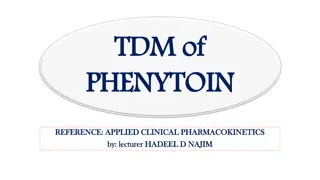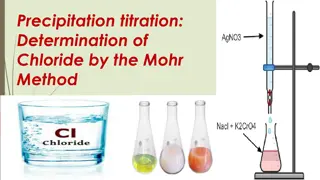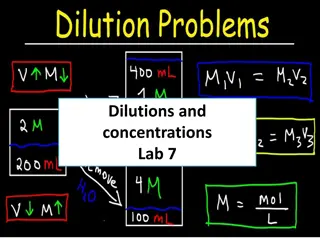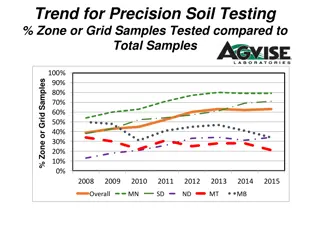Undergraduate Concentrations Information Session
The undergraduate concentrations available in the College of Engineering, including Manufacturing Engineering, Aerospace Engineering, Energy and Sustainability, Technology Innovation, Machine Learning, and Nanotechnology.
0 views • 45 slides
The Role of Inorganic Nitrate in Preventing Contrast-Induced Nephropathy
Contrast-Induced Nephropathy (CIN) poses risks to patients undergoing angiography. This study evaluates the potential benefits of dietary inorganic nitrate in preventing CIN and its mechanisms. Results show promising renoprotective effects, highlighting a potential preventive approach for at-risk pa
1 views • 25 slides
Detector Building
Teams will construct a durable Oxidation Reduction Potential (ORP) probe to measure voltage and NaCl concentrations in water samples. Participants will complete a written test on the event's principles and theories. The competition involves building the device using microcontrollers, sensors, and di
2 views • 15 slides
Understanding the Economic and Health Impacts of Groundwater Nitrate Contamination in Nebraska
The economic and health costs of groundwater nitrate contamination in Nebraska highlight the challenges of ensuring safe drinking water. Despite largely safe levels, proactive strategies are essential due to rising nitrate levels and costly maintenance efforts. The compliance record shows progress i
0 views • 18 slides
Proposed Changes to Guam's Toilet Facilities and Sewer Disposal Act
Current controversies surrounding residential lot sizes, lack of flexibility in existing laws, and rising nitrate levels have prompted the introduction of Bill 175-37 (COR) in Guam. The bill aims to address shortcomings in existing regulations by allowing the development of 1/6 acre lots with Type 4
4 views • 10 slides
Impact of Burning Firewood vs. Compressed Logs on PM2.5 Concentrations
Study comparing the effects of burning firewood and compressed logs on PM2.5 concentrations. Results show that compressed logs produce significantly lower particulate matter pollution. Recommendations include using compressed wood for reduced smoke emission. Various brands and types of compressed lo
0 views • 10 slides
Impurity Determination in Ethyl Alcohol Sample Experiment
Learn how to determine impurities in ethyl alcohol through various tests such as testing for acid presence, detecting foreign smells for other impurities, and checking for the presence of fusel oil. The experiment involves using materials like litmus paper, silver nitrate solution, and sulfuric acid
0 views • 15 slides
Understanding Postmortem Redistribution in Forensic Toxicology
Postmortem Redistribution (PMR) refers to the variation in drug concentrations obtained from postmortem samples, which may not accurately reflect the levels at the time of death due to redistribution mechanisms. In forensic toxicology, assessing drug severity relies on blood concentrations, with cha
0 views • 16 slides
Spectrophotometric Determination of Cr and Mn in Steel Samples
This experiment aims to determine the concentrations of manganese and chromium in steel samples by converting Cr3+ and Mn2+ ions to light-absorbing forms, followed by spectrophotometric measurements at specific wavelengths. Steel samples are oxidized, dissolved, and further oxidized to form dichroma
0 views • 10 slides
Understanding Percent Composition and Empirical Formulas in Chemistry
The Law of Definite Proportions governs the composition of compounds based on molar masses, allowing us to calculate percentage compositions of elements within a compound. Through examples involving various compounds like Fe3C, sulfur dioxide, ammonium nitrate, glucose, and acetic acid, we explore t
3 views • 7 slides
Understanding Phenytoin Therapy - Clinical Pharmacokinetics and Serum Concentrations
Phenytoin, a medication with high protein binding and hepatic metabolism, exhibits saturated pharmacokinetics with a narrow therapeutic range of 10-20 µg/mL for total serum concentrations. Adverse effects vary with serum levels: minor CNS depression at >15 µg/mL, nystagmus at >20 µg/mL, and ataxi
0 views • 55 slides
Gravimetric Determination of Chloride as Silver Chloride
This experiment involves precipitating chloride ions as silver chloride by adding silver nitrate to an acidified chloride solution. The resulting silver chloride precipitate is coagulated, filtered, and weighed to determine the chloride content gravimetrically. Factors affecting the solubility of si
0 views • 13 slides
Determination of Chloride by Mohr Method
Precipitation titration is a volumetric method used for determining chloride ions. Mohr's method involves reacting alkaline or alkaline earth chlorides with silver nitrate in the presence of a potassium chromate indicator. The endpoint of the titration is signaled by the appearance of red silver chr
0 views • 9 slides
Understanding Digoxin Pharmacology and Clinical Use
Digoxin, a cardiac glycoside, is utilized in managing congestive heart failure and atrial fibrillation due to its inotropic and chronotropic effects on the heart. It functions by inhibiting Na,K-ATPase, leading to increased intracellular calcium concentrations and augmented myocardial contractility.
5 views • 23 slides
Understanding Concentration in Solutions
Solutions involve the dissolution of solutes like salt or sugar in solvents such as water, resulting in different concentrations. This concentration can be expressed as moles per liter, known as molarity. By calculating the amount of substance in moles using solution volume and concentration, you ca
0 views • 8 slides
Safety Regulations Intensify as Ammonium Nitrate Market Responds to Increased Ag
Ammonium Nitrate Market By Product Type (Solid ammonium and Liquid ammonium), By Application (Fertilizers, Explosives and Other Applications), By End Use(Agriculture , Mining, Defence, Others), By Region and Companies - Industry Segment Outlook, Mark
0 views • 4 slides
Understanding Dilutions and Concentrations in Lab Experiments
Dilution and concentration are key concepts in laboratory experiments where solutions of different concentrations are adjusted to achieve specific concentrations. The process involves diluting high concentration solutions with suitable diluents or concentrating low concentration solutions by various
0 views • 15 slides
Understanding Argentometric Methods in Pharmaceutical Chemistry
Argentometric methods, as taught by Lecturer Luma Amer from the Department of Pharmaceutical Chemistry at the College of Pharmacy, involve titrations using silver-based compounds like silver nitrate. These methods have limitations due to co-precipitation effects and limited indicator choices. Parame
0 views • 14 slides
Diluting Solutions in Chemistry
Diluting solutions is a common practice in chemistry to prepare solutions of different concentrations for various experiments and analyses. This involves diluting stock solutions to desired concentrations using the formula M1V1 = M2V2. The process includes preparing calibration curves, determining m
0 views • 6 slides
Understanding PK/PD Approach for Antibiotics: In Vivo Efficacy Indices
Exploring the PK/PD approach for antibiotics involves considering factors such as dose administered, in vitro therapeutic effect, MIC, rates of bacterial killing, and plasma concentrations to predict treatment efficacy. The location of pathogens, binding to plasma proteins, and tissue concentrations
0 views • 27 slides
Understanding PK/PD for Antibiotics: In Vivo Efficacy Indices
This information delves into the PK/PD approach for antibiotics, emphasizing the importance of plasma concentrations in controlling infection site concentrations, details on pathogen locations, binding to plasma proteins, and the significance of tissue concentrations for predicting treatment efficac
1 views • 27 slides
Academic Planning Training Summit Exec Order 1071 - Units & Concentrations
Explore Executive Order 1071 delegating authority for subprograms in academic planning. Learn about counting units, adding concentrations, and major requirements. Guidance documents and comparisons help understand the core curriculum and exclude elective units. Dive into discipline major units, conc
0 views • 12 slides
Exploring Copper Sulfate, Sodium Nitrate, and Ammonium Chloride in Chemistry Projects
Delve into the properties and uses of copper sulfate, sodium nitrate, and ammonium chloride in chemistry projects. Discover how these chemical compounds play vital roles in agriculture, industry, and everyday applications, from fungicides to food additives.
0 views • 9 slides
Reducing Hydrogen Pickup in CANDU Zr-2.5Nb Pressure Tubes
This study focuses on reducing the hydrogen pickup during the processing of CANDU Zr-2.5Nb pressure tubes. Various stages in the processing are detailed, and the hydrogen concentrations in different reactor sets of pressure tubes made before 1990 are analyzed. The desire is to lower the initial hydr
1 views • 22 slides
Investigation of Potato Slices in Various NaCl Solutions
Experiment conducted by the National Team of Iran at IYNT 2013 involving slicing potatoes into rectangular bars and immersing them in NaCl solutions of different concentrations to observe how the slices behave. The experiment aimed to study biological side contouring, propagation regulation, and the
0 views • 13 slides
Understanding Fermi-Dirac Statistics in Solids
Electrons in solids obey Fermi-Dirac statistics, governed by the Fermi-Dirac distribution function. This function describes the probability of electron occupation in available energy states, with the Fermi level representing a crucial parameter in analyzing semiconductor behavior. At different tempe
0 views • 9 slides
Feasibility of Using Fe0 to Remediate Groundwater Lead Pollution in an Abandoned Tailings Dam
Heavy metal pollution in soil and groundwater from an abandoned tailings dam poses a persistent challenge. This study explores using iron (Fe0) in a Permeable Reactive Barrier (PRB) to remove lead (Pb) via redox reaction. The contaminated area, impacted by lead pollution, underwent experiments to as
0 views • 17 slides
Study on Coatings Composition and Performance
The study investigated the targeted and measured concentrations of Ti and Zr in magnetron-sputtered coatings, their impact on conversion layer thickness, and the relative atomic concentrations in hydrothermal conversion layers on Al-12Zr and Al-12Ti. Open circuit potential values before and after hy
0 views • 4 slides
Trends in Precision Soil Testing and Average Soil Nitrate Levels (1986-2015)
This detailed content provides insights into the trends in precision soil testing, comparing zone/grid samples to total samples, and the variability of soil nitrate levels following wheat and barley crops. It includes visual representations of data from various regions and years, offering valuable i
0 views • 39 slides
Anacostia River Tributary Sediment Study 2018
This study focuses on analyzing bottom sediment samples from five major tributaries of the Anacostia River to determine concentrations of contaminants of concern (COCs) and identify possible point sources of pollution. The research aims to establish anthropogenic background concentrations, compare t
0 views • 10 slides
Exploring Silly Putty: Borax Concentrations and Material Properties
Created by mixing borax with glue, silly putty is a fascinating material with varying properties based on borax concentrations. Through a hands-on experiment, participants make different batches of silly putty to observe how high, medium, and low borax concentrations affect its texture and behavior.
0 views • 4 slides
Radon Concentrations in New-Built Swedish Dwellings: Findings from International Radon Symposium
Large decrease in radon concentrations observed in newly built Swedish dwellings, with data analyzed from 1950 to 2016. Dependencies between building year, foundation type, ventilation, and radon levels were evaluated. Results compared against the Swedish reference level of 200 Bq/m3. Measurements i
0 views • 14 slides
Modeling the Impact of Oil and Gas Emissions on Ozone in New Mexico
Tammy M. Thompson, a Senior Air Quality Scientist at the Environmental Defense Fund, discusses the modeling of ozone from oil and gas production emissions in New Mexico. The analysis focuses on areas with high ozone concentrations and their overlap with oil and gas regions, highlighting the sensitiv
0 views • 8 slides
Trends in Nitrate Concentrations in Suffolk County Public Water-Supply Wells 1982-2008
This study analyzes trends in nitrate concentrations in public water-supply wells in Suffolk County, New York, from 1982 to 2008. Groundwater is a crucial source of drinking water, with potential impacts on coastal waters. The analysis reveals increasing nitrate trends over both long and short terms
0 views • 17 slides
Exothermic and Endothermic Reactions of Different Substances
Learn about the concepts of exothermic and endothermic reactions, featuring specific substances like sodium hydroxide, lithium nitrate, ammonium nitrate, crystalline ammonium nitrate, and potassium bromide. Discover their properties, uses, and how they interact with water. Explore how these reaction
0 views • 5 slides
Trends in Precision Soil Testing and Soil Nitrate Levels in Agriculture
Explore the trends in precision soil testing, zone/grid samples compared to total samples, nitrate levels following wheat and canola crops, and soil nitrate variability between fields in Canada. The data spans from 1986 to 2015, showcasing shifts in agricultural practices and soil health indicators
0 views • 35 slides
Laboratory Preparation of Nitric(V) Acid & Chemical Reactions
In this set of questions, we explore the preparation of nitric(V) acid in a school laboratory setting, its properties, and chemical reactions. Topics covered include the use of sodium nitrate(V) and potassium nitrate(V), the use of glass apparatus during the preparation process, color changes in con
0 views • 4 slides
Understanding pH and pOH Conversions in Chemistry
Learn how to convert between pH, pOH, [H+], and [OH-] concentrations in chemistry. Discover the steps to recover original H+ and OH- concentrations from pH and pOH values, along with examples and computations. Explore the traditional methods of measuring pH using indicators and pH electrodes.
0 views • 20 slides
Understanding Polyprotic Acids and Salts in Chemistry
Exploring the concept of polyprotic acids, particularly focusing on sulfuric acid as a unique example with its dual dissociation steps. The discussion delves into the equilibrium concentrations of ions in solution, calculating pH values for different acid concentrations, and understanding the signif
0 views • 18 slides
Learning Chemistry Through Epidemic Prevention
Explore the use of bleach in epidemic prevention through engaging learning activities that involve understanding bleach concentrations, chemical reactions, and safety measures. Students will gain knowledge on using bleach effectively, converting concentrations, and investigating chemical properties,
0 views • 11 slides







































